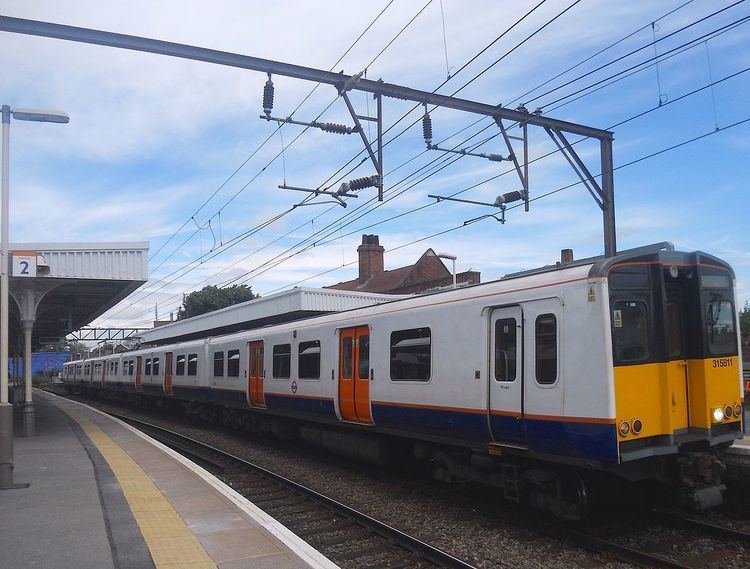In service 1980 - present Family name BREL 1972 "PEP" Number built 61 sets | Constructed 1980 - 1981 | |
 | ||
Refurbishment 1st refurbishment: All 61 sets 2004 - 2008Bombardier Derby2nd refurbishment: London Overground and TfL Rail 2015 - 2016Bombardier Ilford | ||
British Rail Class 315 alternating current (AC) electric multiple units (EMU) were built by BREL York works from 1980 to 1981. They were the fifth and final variant of British Rail's then-standard 1972 design for suburban EMUs, which eventually encompassed 755 vehicles and five Classes (Class 313/314/315/507/508). Like the Glasgow-based Class 314 units, they are only able to operate from the 25 kV overhead line.
Contents
The fleet works inner-suburban TfL-run services on the Shenfield Metro for TfL Rail and the Lea Valley Lines for London Overground out of London Liverpool Street.
Description
Each Class 315 unit is formed of four vehicles; some vehicles are attached to another set of four vehicles to make 8 vehicles. In the past, some further vehicles attached to another four to make 12 vehicles on long distance journeys, such as ones to Southend Victoria or Southminster (operated by Greater Anglia). The vehicles include: Driving Motor Standard Open (DMSO), Pantograph Trailer Standard Open (PTSO), Trailer Standard Open (TSO), and Driving Motor Standard Open (DMSO). Each DMSO carries four traction motors (315801-841 originally had Brush TM61-53 and 315842-861 had GEC G310AZ but these motors are interchangeable and nowadays any type can be found on any unit) rated at 110hp each and a main compressor and air reservoir which carries air for the brakes and suspension. The original pneumatic door system has been replaced by an all-electric door system. The PTSO carries the main and auxiliary transformers, batteries and battery charger, Stone Faiveley AMBR Mk.1 pantograph, vacuum circuit breaker and auxiliary compressor. The TSO carries no equipment other than that which is standard to all coaches.
The coaches only contain standard seating and have no toilet facilities. Car numbering is as follows:
Each 4-car set is able to seat 318 passengers.
A refurbishment programme commenced from mid-2004, when National Express East Anglia (then 'one' Railway) contracted Bombardier to carry out the refurbishment of all 61 units, starting with the ex-First Great Eastern examples. The low-back 3+2 seating is retained, so the capacity stays the same.
The Class 315 units replaced the life-expired Class 306 units. They will be displaced from Shenfield Metro work as part of Crossrail, and from Lea Valley services after they are taken over by London Overground.
Historical services
Following the privatisation of British Rail, the Class 315s were divided between First Great Eastern (43 units) and West Anglia Great Northern (18 units). The leasing company HSBC Rail has owned the entire Class 315 fleet since privatisation, though it has since been renamed Eversholt Rail Group.
From April 2004, National Express East Anglia (NXEA) ran the inaugural Greater Anglia rail franchise, which combined the previous operations of both First Great Eastern and WAGN, meaning the two Class 315 fleets were combined. The franchise was initially known as 'One' but was rebranded National Express East Anglia (NXEA) in February 2008.
The Class 315 fleet transferred to new operator Abellio Greater Anglia in February 2012. Abellio repainted the trains in its own livery, and undertook a refresh of the fleet, including a Passenger Information System and a flexible space for wheelchairs and cycles which includes tip-up seating and 'call to aid' buttons. Abellio used the fleet for local services out of London Liverpool Street to Shenfield (the popular Shenfield Metro service) on the Great Eastern Main Line and Cheshunt, Enfield Town and Chingford on the Lea Valley Lines. They are also seen on the Upminster Branch Line between Romford and Upminster, a duty shared with Class 317s.
However, until the end of operation by Abellio Greater Anglia, a number of them were found running further afield, running on the Great Eastern and West Anglia Main Lines at peak times only to Bishop's Stortford, Broxbourne, Southminster and Southend Victoria. They also covered for unavailable Class 360s, Class 321s or Class 90s on these services as often 315s were the only spare trains available. During National Express' operation of the franchise, it was rare for 315s to run beyond Shenfield, but since Abellio began running the railway, the practice became more common. These units ran to Cambridge, Ely, King's Lynn, Stansted Airport, Braintree, Colchester, Clacton-on-Sea, Walton-on-the-Naze, Harwich Town and Ipswich on occasions when the normal units used on these services were not available.
Initially, the Shenfield Metro and Upminster Branch Line services used only sets 315801-843 and the Lea Valley Lines only 315844-861, reflecting the allocations of the former franchises.
All 61 sets were then used interchangeably, operating out of Ilford depot.
Current services
The current operators are London Overground, who use sets 315801 - 315817 on West Anglia inner services and Romford to Upminster services. They are also operated by London Overground's sister company, TfL Rail, who use sets 315818 - 315861 on Shenfield metro services.
In July 2015, TfL confirmed that it would place a £260m order for 45 Bombardier Aventra EMU Class 710 trains, which would replace London Overground's 315s. The 710s will be introduced on the West Anglia Routes, taken over from Abellio Greater Anglia in May 2015, in 2018.
Additionally, TfL Rail's 315s will be replaced by new Class 345 Aventra trains in 2017-2018 and it has been suggested that these 315s could be cascaded to the Wales and Borders passenger franchise to be used on Valley Lines services in the Cardiff area following electrification.
